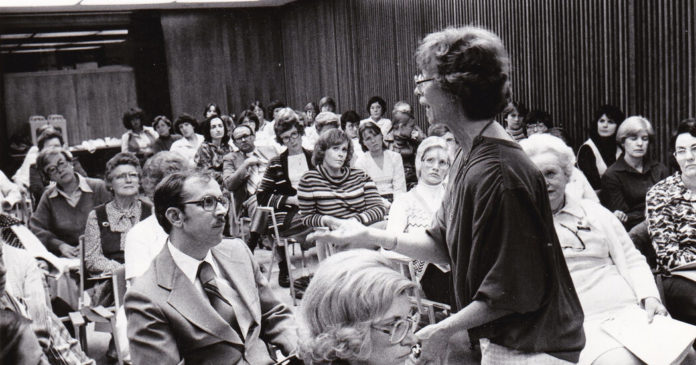Naomi Feil was only 8 years old when she moved into what was then known as a home for the aged, where her parents worked. Living there until she left for college, she learned firsthand, by trial and error, how to comfort and communicate with older adults.
When she died at 91 on Dec. 24 at her home in Jasper, Ore., she had devoted her entire career to finding ways to comfort disoriented older people and their caregivers.
Her daughter Vicki de Klerk-Rubin said she died of cancer.
Mrs. Feil was a 24-year-old social worker, convening a group of patients diagnosed as “senile psychotic,” when a staff psychologist at the Montefiore Home for the Aged in Cleveland laid the foundation for what would become the method she called validation therapy.
“He taught us when feelings are ‘validated’ they are relieved,” Mrs. Feil explained on the website of her nonprofit Validation Training Institute in Pleasant Hill, Ore. “‘You are validating your residents, helping them release their pain.’ When social work students asked me what I was doing, I answered: ‘Validation.’ And so a new way of relating was formed.”
Her method calls for caregivers to empathize with disoriented individuals in an effort to reduce their stress and support their dignity, rather than try to impose reality on them.
“If you validate someone, you accept them where they are and where they’re not,” Mrs. Feil (pronounced “feel”) often said. “If you accept them, then they can accept themselves.”
As she refined her methods, she founded the nonprofit Validation Training Institute in 1982. She directed it until 2014 when she was succeeded by Ms. de Klerk-Rubin, her daughter.
“She was a pioneer in this area of person-centered dementia care,” Sam Fazio, the senior director of quality care and psychosocial research at the Alzheimer’s Association, said in a phone interview. “What’s key in connecting with a person with cognitive impairment is to meet them in their reality instead of expecting them to meet us in ours.”
Her theory, like a related one called therapeutic deception, was not without its critics. The main objection is that it condones lying. The British Alzheimer’s Society has said that “we struggle to see how systematically deceiving someone with dementia can be part of an authentic trusting relationship.” Others argue that lying, or accepting a patient’s delusion as reality, is justified when it is in the patient’s best interest.
There is still no consensus.
According to the Validation Training Institute, more than 9,000 people in 14 countries have been trained to communicate with people with declining cognitive abilities, especially dementia, by expressing empathy.
Mrs. Feil wrote two books: “Validation: The Feil Method, How to Help the Disoriented Old-Old” (1982) and “The Validation Breakthrough” (1993). She collaborated on a later edition of “The Validation Breakthrough” with Ms. de Klerk-Rubin.
She and her husband, Edward R. Feil, a professional filmmaker, collaborated on a number of documentaries, including “The Inner World of Aphasia” (1968), which was placed on the United States National Film Preservation Board’s film registry in 2015.
Gisela Noemi Weil was born on July 22, 1932, in Munich to Jewish parents. By the time she was 5, her family had fled Nazi Germany for the United States, where her father, Julius Weil, became director of the Montefiore Home for the Aged in Cleveland, and her mother, Helen (Kahn) Weil, ran the home’s social service department.
After studying at Oberlin College in Oberlin, Ohio, and Western Reserve University (now Case Western Reserve University) in Cleveland, and earning her master’s degree from the Columbia University School of Social Work in New York in 1956, she married Warren J. Rubin. Their marriage ended in divorce.
She then moved to Cleveland and returned to the Montefiore Home, this time as a member of the professional staff. She married Mr. Feil in 1963; he died in 2021.
In addition to Ms. de Klerk-Rubin, her daughter from her first marriage, Mrs. Feil is survived by another daughter from that marriage, Beth Rubin; two sons from her second marriage, Edward G. Feil and Kenneth Jonathan Feil; six grandchildren; and one great-granddaughter.
She and Mr. Feil moved from Ohio to Eugene, Ore., in 2015 to live on their son Edward’s farm, where Mr. Feil, who was suffering from cognitive decline, received full-time home nursing care, piano lessons, painting classes and validation therapy.
In the early 1960s, when she started working with disoriented people over 80, Mrs. Feil realized that helping them to face reality was an unrealistic goal, one that would frustrate the caregiver and the invalid alike.
“Each person was trapped in a world of their own fantasy,” she wrote in her first book.
“I learned validation from the people with whom I worked,” she added. “I learned that they have the wisdom to survive by returning to the past.”
Source : Nytimes













